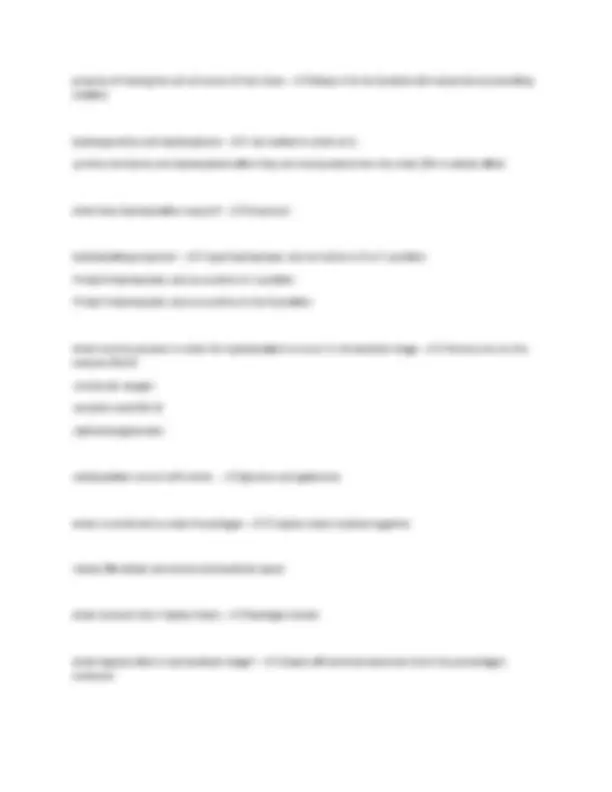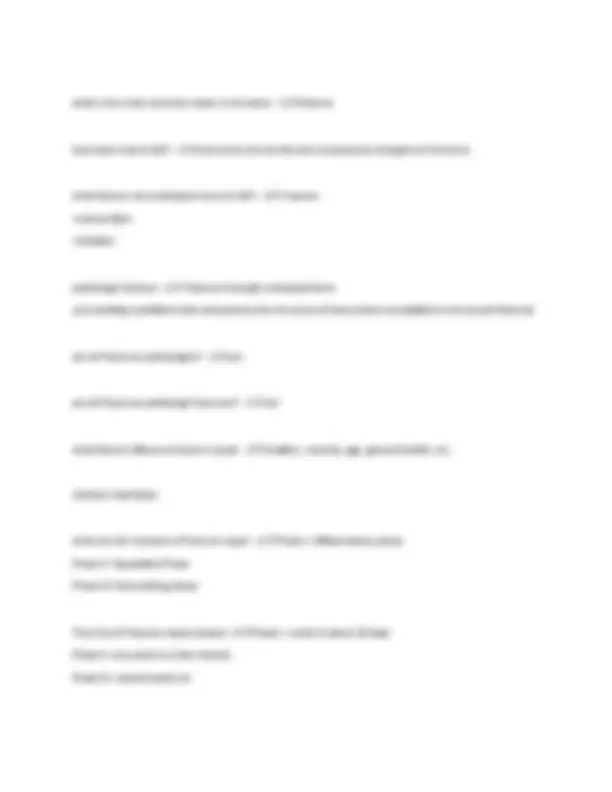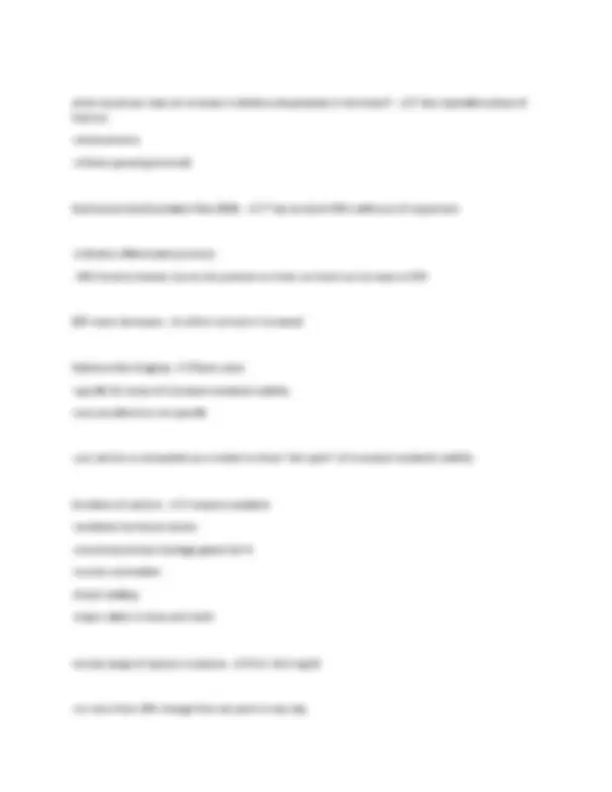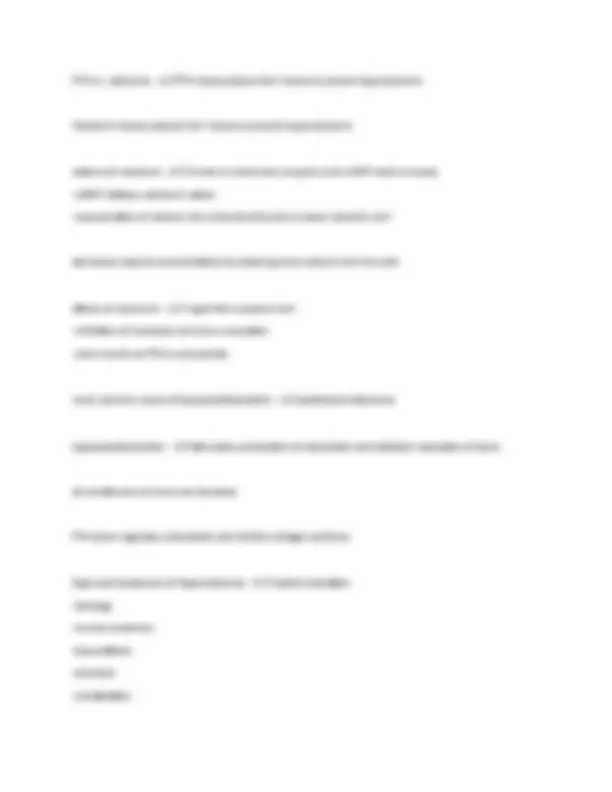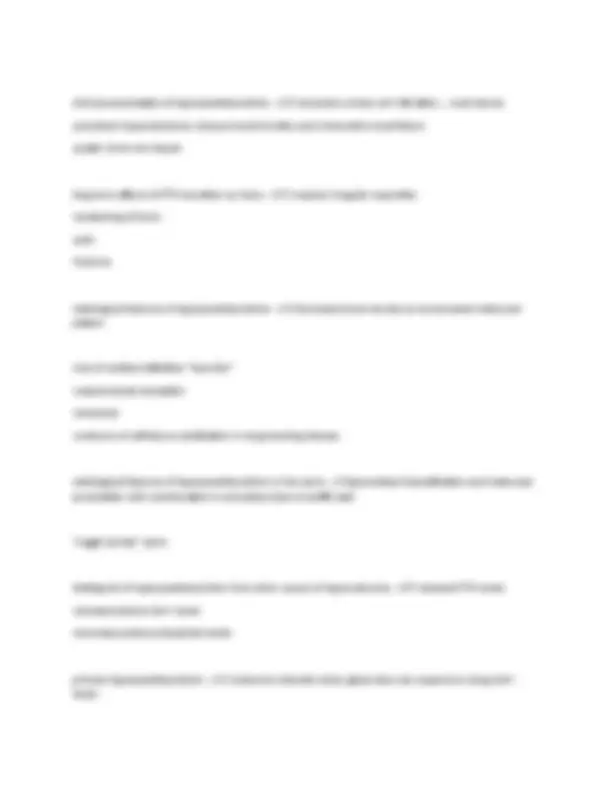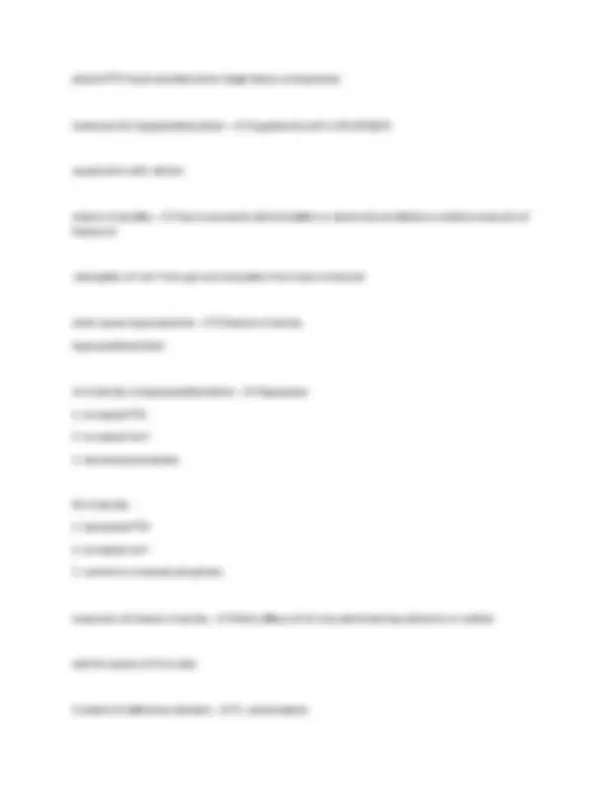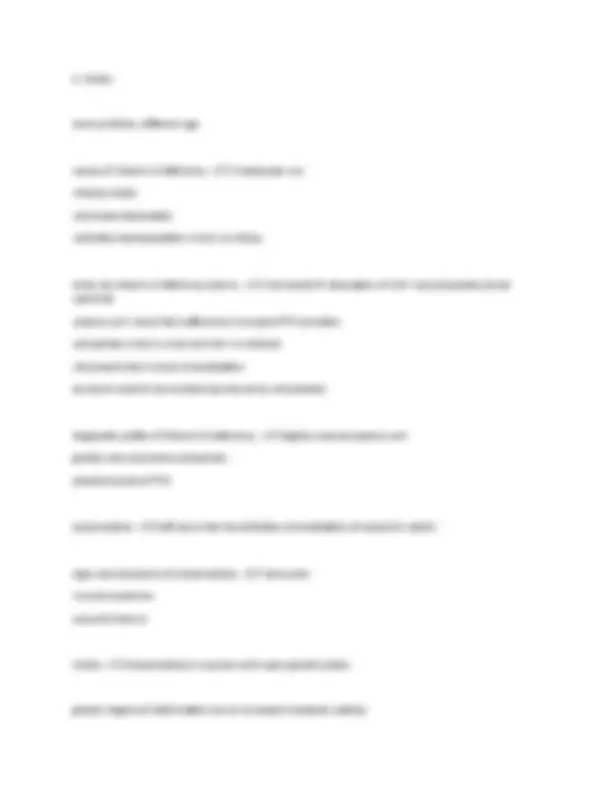Download Bone Physiology and Pathology and more Exams Nursing in PDF only on Docsity!
MSP Test 1 Prep | Actual Exam Questions |
100% Correct Answers | Verified
2024 Version
most versatile type of connective tissue - ✔✔fibroblasts what can fibroblast differentiate into? - ✔✔
- bone
- fat
- smooth muscle
- cartilage when do fibroblast become cartilage? - ✔✔when in an enviornment without oxygen and cartilage is avascular when does cartilage become fibroblast - ✔✔when oxygen is introduced to the cartilage is morphs back what cells produce type I collagen? - ✔✔ bone fat smooth muscle what cells produce type II collagen? - ✔✔cartilage least specialized cell in body - ✔✔fibroblasts
- allows it to morph easily
what embryonic derivative are fibroblast - ✔✔mesodermal derivative what do fibroblasts secrete? - ✔✔extracellular matrix
- collagen
- prosteoglycans
- elastin
- fibronectin and other structural proteins what is collagen - ✔✔-present in almost all organs
- holds cells together
- gives tissue structural integrity mammalian protein - ✔✔25% of all mammalian protein is collagen signs and symptoms a patient with collagen synthesis disorder may present with - ✔✔-excessive bleeding
- hypermobility
- joint laxity
- bone fragility
- slower healing time sign vs. symptom - ✔✔sign- what doctor observes symptom- what patient complains of collagen synthesis stages - ✔✔1. intracellular stage
- extracellular stage
purpose of having the set structure of the chain - ✔✔allows it to be durable with extensions preventing rotation hydroxyproline and hydroxylysine - ✔✔-not added to chain as is
- proline and lysine are hydroxylated after they are incorporated into the chain (OH is added after) what does hydroxylation require? - ✔✔enzymes! hydroxylating enzymes! - ✔✔-Lysyl hydroxylase: acts on lysine in X or Y position
- Prolyl- 4 - hydroxylase: acts on proline in Y position
- Prolyl- 3 - hydroxylase: acts on proline in the X position what must be present in order for hydroxylation to occur in intracellular stage - ✔✔-ferrous ion on the enzyme (Fe2+)
- molecular oxygen
- ascorbic acid (Vit C)
- alpha ketogluterate carboxylation occurs with what.. - ✔✔glucose and galactose what is combined to make Procollagen - ✔✔3 alpha chains twisted together
- leaves fibroblast and enters extracellular space what connects the 3 alpha chains - ✔✔hydrogen bonds what happens first in extracellular stage? - ✔✔cleave off terminal extension from the procollagen molecule
requires enzyme procollagen peptidase tropocollagen - ✔✔-when terminal extensions are gone
- immature collagen and doesn't have necessary tensile strength how is a mature collagen fiber formed - ✔✔further cross linking via inter and intrachain hydrogen bonds necessary Scurvy - ✔✔-hydroxylation step is interrupted
- problem adding OH group *reversible with with C Ehlers-Danlos and Dermatospiraxis - ✔✔ED- in humans Derm- in cattles problem with procollagen peptidase
- cant put molecules of collagen together (structure is compromised)
- increased risk of infection hereditary problems with collagen synthesis - ✔✔-marfans syndrome
- osteogenesis imperfecta bone function - ✔✔-protection
- support
- mechanical basis for movement
- hematopoiesis
- mineral storage
ex. axial and appendicular bones how are a majority of bones formed - ✔✔endrochondral bones what does bone heal with - ✔✔itself. bone heals with bone how many sites of ossification do bones have - ✔✔carpals and tarsals- carilage is replaced at primary site of ossification vertebrae and long bones have multiple sites of ossification- primary, secondary, and tertiary what happens with bone formation at the end of puberty - ✔✔-rate of ossification exceeds growth of epiphyseal cartilage proliferation and growth plate closes ends in females 3 years before males what pathological condition might show the presence of alkaline phosphatase in a blood test - ✔✔osteosarcoma can show how aggressive or how much of the skeletal system is involved in the pathology what may happen is theres a disruption of the growth plate - ✔✔effect the length of the bone what could cause a disruption in the growth plate - ✔✔-fracture through growth plate
- nutritional issues
- infection
Polio - ✔✔infection that affects the growth plate results in the effected limb being shorter poliomyelitis - ✔✔pathology of growth plates
- frequent cause of improper growth of a limb
- mechanism of the disease is unknown two ways to prevent limb length discrepancies - ✔✔-remove growth plate
- pressure on growth plate by stapling the epiphysis to metaphysis how does membranous bone grow - ✔✔process of accretion accretion - ✔✔process of adding bone to the surface and edges of the bones ex. closure of the fontanels what secretes the bone matrix - ✔✔osteoblasts that are at the surface of the exisiting matrix appositional bone growth - ✔✔-osteocyte
- osteoid (junk in matrix: yet to be turned into bone)
- ossification ability of bone to adapt - ✔✔wolff's law:
- depositing bone matrix
- eroding bone matrix wolffs law governing bone remodeling - ✔✔-distal segment moves in relation to proximal segment
what is the most common lesion in the bone - ✔✔fracture how does a bone fail? - ✔✔overcomes the tensile and compressive strengths of the bone what factors can predispose bone to fail? - ✔✔-trauma
- malnutrition
- infection pathologic fracture - ✔✔-fracture through a diseased bone
- pre-existing conditions that compromise the structure of bone (more susceptible to structural fracture) are all fractures pathologies? - ✔✔yes are all fractures pathologic fractures? - ✔✔no! what factors influence fracture repair - ✔✔location, severity, age, general health, etc. children heal faster what are the 3 phases of fracture repair - ✔✔Phase I- Inflammatory phase Phase II- Reparative Phase Phase III- Remodeling phase Time line of fracture repair phases - ✔✔Phase I- onset to about 10 days Phase II- one week to a few months Phase III- several weeks on
- fracture will eventually reunion but will always be remodeling Inflammatory phase (1-2 days post fracture) - ✔✔1. rupture of blood vessels in soft tissue and bone
- Hematoma fills gaps and seals off fracture
- tearing of the periosteum (highly innervated and painful)
- Necrosis of bone and soft tissue- due to interrupted blood flow Inflammatory phase (2-5 days post fracture) - ✔✔1. fibrin mesh develops
- fibroblasts migrate to the area (become chondrocytes due to damaged blood vessels)
- begin to form and lay down cartilage between bone ends
- necrosis and macrophage activity continues (PMNs) Inflammatory phase (5-10 days post fracture) - ✔✔1. soft tissue callus (procallus) begins to form - accumulation of cartilage
- macrophage activity continues- discontinuity becomes wider due to cleaning of debris Reparative Phase - ✔✔1. early part continuous with latter part of inflammatory phase
- osteoclasts and mononuclear cells clean up debris
- extensive neovascularization
- fracture may appear wider on x-ray
- callus formation begins (vascularization starting- hazy cloud in area of discontinuity)
- significant osteoblastic activity occuring what must be present to change cartilage to bone? - ✔✔vasculature! Remodeling phase - ✔✔1. occurs once callus has stabilized bone
- bone adjusts its strength and shape clinical union - ✔✔implies fracture is stable
- pointed ends (skiing accidents) Bone Bruise - ✔✔-hemorrhage, edema, trabecular microfracture
- not seen on radiographs; need to do MRI
- deep ache in the bone (fluid black on T1; fluid white on T2 for MRI) open vs closed fractures - ✔✔also know as compound vs. simple closed- does not break skin open- breaks skin; exposed to outside world imcomplete vs. complete fractures - ✔✔-refers to discontinuities in cortex or bones
- complete more likely to cause displacement greenstick or torus fractures - ✔✔-incomplete fractures in skeletally immature individuals
- buckling or bending occurs due to the 1:1 ratio of inorganic to organic ratio avulsion fracture - ✔✔-forcible ripping or tearing of tissue
- tearing away of bone fragment
- pull from ligament, tendon, or muscle clay shoveler or coal miners fracture - ✔✔-avulsion of lower cervical segment spinous process
- traps ripped them off
occult fracture - ✔✔-radiographically invisible fracture!
- re-radiograph in 7-10 days to look for a widening in radiolucency.. re-radiograph 2 weeks after that to look for hazy cloud
- most common in scaphoid
- ribs 2nd Comminuted fractures - ✔✔two or more fragments that have seperated from bone
- crushed of pulverized bone "butterfly fragment" Noncomminuted fracture - ✔✔one break, 2 fragments compression vs. impaction fractures - ✔✔-frequently due to axial compression compression- describes vertebral fractures (ant. portion of body is shorter than post.) impaction- used for bones in extremities fatigue or stress fracture - ✔✔-abnormal stress on normal bone
- repetitive stress causes gradual formation or microfracture stress fracture through diseased bone- a form of pathologic fracture March fracture - ✔✔-type of stress fracture
- 2nd and 3rd metatarsal happens in boot camp what secretes alkaline phosphatase? - ✔✔osteoblasts when depositing bone
calcium in blood - ✔✔50% ionzied Ca++ is biologically active 40% is bound to albumin and is unavailable to body 10% complexed in non-ionic filterable form like Ca++ bicarbonate what regulates plasma calcium levels - ✔✔bone gut kidney GI system and calcium balance - ✔✔% of dietary intake absorbed is inversely related to intake
- prevents overload with dietary supplements
- dietary deprivation causes an increase in Ca++ absorption three hormones that regulate Ca++ movement between bone, gut and kidney - ✔✔1. parathyroid hormone
- calcitriol or Vit D (1-25)
- calcitonin what is the major regulator of plasma calcium - ✔✔parathyroid hormone relationship between calcium and PTH - ✔✔secretion of PTH is inversely related to plasma calcium levels *negative feedback pair
- monitored by glands CaSR - ✔✔calcium sensing receptor on cell membrane monitors release of PTH
time of PTH half life - ✔✔less than 20 minutes
- ionized Ca regulates PTH secretion in minutes sustained Hypercalcemia on PTH - ✔✔elevated levels of Ca++ shut down PTH synthesis and degrade stores hypertrophy of PTH - ✔✔low Ca++ levels cause constant secretion of PTH until it burns out PTH function - ✔✔raise Ca++ levels by acting on bone, kidney, and gut PTH action on bone - ✔✔-stimulates osteolysis by osteocytes in bone and osteoblasts on cell surface to remove calcium phosphate salts from bone
- stimulates Ca++ pumps on ECF side- allows calcium to diffuse into cell from bone
- via paracrines it stimulates production of osetoclasts and activates resorption of bone PTH on kidney - ✔✔-increase Ca++ reabsorption from distal tubule *more dramatic effect is to inhibit reabsorption of phosphate stimulates synthesis of Vit D metabolite PTh action on gut - ✔✔indirect: via calcitriol and calbinding production and release calbindin facilitates active transport of Ca++ across gut wall functions of phosphate - ✔✔-all glycolytic compounds
- atp, adp, amp, creatine phosphate
- nad, nadh
D2 has two more double bonds biologically act the same in body liver and vitamin D - ✔✔liver modifies it for the first time 25 (OH)D kidney and vitamin D - ✔✔ 1 - 25 (OH2)D aka calcitriol which is made under PTH influences action of 1-25 Metabolite in kidney - ✔✔-binds with cytosolic receptor and enters nucleus
- stimulates protein synthesis of calbindin calbindin helps facilitate calcium absorption from the guy phosphate absoprtion across gut is also stimulated by Vit D action of 1-25 metabolite in bone - ✔✔stimulates bone resorption working synergistically with PTH sytosolic receptor is found in osteocytes and osteoclasts action of vitamin D - ✔✔normal mineralization of bone is dependent on vitamin D major storage site for vitamin D - ✔✔muscle muscle weakness seen with vit d deficiency calcitonin - ✔✔hormone produced by parafollicular cells of thyroid gland
PTH vs. calcitonin - ✔✔PTH raises plasma Ca++ levels to prevent hypocalcemia Calcitonin lowers plasma Ca++ levels to prevent hypercalcemia actions of calcitonin - ✔✔-binds to membrane receptors and cAMP levels increase
- cAMP initiates calcitonin action
- sequestration of calcium into mitochondria acts to lower cytosolic ca++ aka lowers plasma concentrations by allowing more calcium into the cells effects of calcitonin - ✔✔-rapid fall in plasma Ca++
- inhibition of osteolysis and bone resorption
- same results as PTH on phosphate most common cause of hyperparathyroidism - ✔✔parathyroid adenoma hyperparathyroidism - ✔✔stimulates production of osteoclasts and activates resorption of bone all constituents of bone are liberated PTH down regulates osteoblasts and inhibits collagen synthess Signs and Symptoms of Hypercalcemia - ✔✔-dulled mentation
- lethargy
- muscle weakness
- hyporeflexia
- anorexia
- constipation


